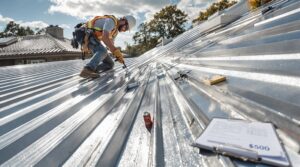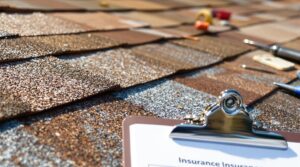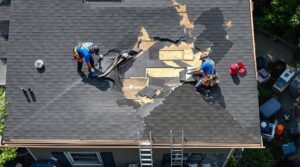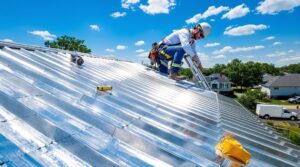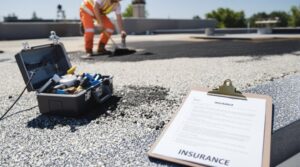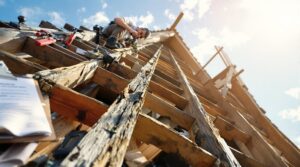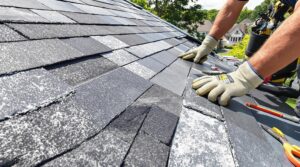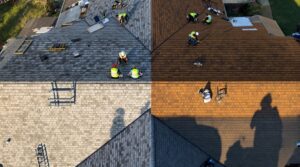Is your clay or concrete tile roof giving you trouble? Let's dive into the world of tile roof repairs – it's not as daunting as you might think!
Think of clay and concrete tiles as your roof's protective armor, each with its own unique repair needs. Clay tiles, the classic beauties, work best with RT-600 sealant and roofing cement – kind of like matching the right medicine to the ailment. Their concrete cousins prefer foam adhesive, which acts like a strong handshake keeping everything firmly in place.
When it comes to your wallet, tile roof repairs typically run between $4-$14 per square foot, with skilled craftsmen charging $50-$100 per hour. Just like a doctor’s visit, expertise comes at a price, but it’s worth every penny for proper protection. It’s important to remember that different issues may arise with your roof, and knowing the various solar tile roof repair types can help you communicate effectively with your contractor. Whether it’s a simple leak or more extensive damage due to weather, understanding the specific repairs needed will ensure you receive an accurate estimate. Investing in high-quality materials and skilled labor now can save you from costly repairs down the line, providing peace of mind for years to come.
Want to make the most of your home insurance? Smart documentation is your best friend here. Working with a public adjuster can be a game-changer – they're like skilled negotiators who often boost claim settlements by up to 50% compared to initial offers.
By understanding these repair essentials, you're not just fixing a roof – you're investing in your home's long-term health and value. Ready to tackle that tile repair? Your roof (and your peace of mind) will thank you!
Key Takeaways
Want to know the real scoop on tile roof repairs? Let's break it down in a way that won't make your head spin!
Think of clay and concrete tiles as the dynamic duo of roofing – clay being the luxury superhero ($3-$11 per square foot) and concrete the budget-friendly sidekick ($3-$5). But don't forget their trusty installer, who'll charge you $4-$14 per square foot to get the job done right.
Got a cracked tile situation? No worries! Each material has its go-to fix: RT-600 works like magic for clay tiles, while foam adhesive is concrete's best friend. Both types need a mortar seal to keep everything snug as a bug.
Here's the thing about professional repairs – they're like having a skilled surgeon for your roof. At $50-$100 per hour (with a starting fee of $300-$500), you're not just paying for repairs; you're investing in expertise and peace of mind through liability coverage.
Did you know clay tiles are like the tortoises of the roofing world? They can stick around for a century, thanks to their impressive 6% water absorption rate. Their concrete cousins aren't far behind, bringing Class A fire protection and a similarly impressive lifespan to the table.
Dealing with insurance claims? Documentation is your best friend! Consider working with a public adjuster – they're like expert negotiators who can boost your settlement by up to 50%. Pretty sweet deal, right?
Remember: The better you maintain your tile roof, the longer it'll keep you covered – literally!
Understanding Clay and Concrete Roof Tiles
When considering roofing materials, clay and concrete tiles represent two distinct yet similarly durable options for residential and commercial applications.
The key clay tile characteristics include a composition of molded clay or shale fired at 1300 degrees Celsius, resulting in exceptionally low water absorption rates of 6% and lifespans up to 100 years.
Concrete tile benefits stem from their versatile composition of sand, cement, and aggregates, manufactured under controlled conditions.
Concrete tiles deliver exceptional performance through precision manufacturing, combining sand, cement and aggregates into a robust roofing solution.
These tiles achieve Class A fire ratings and demonstrate remarkable wind resistance. While concrete tiles offer a 50-year lifespan and cost-effective installation, they require stronger structural support due to their weight.
Both materials provide excellent durability and weather resistance, though clay tiles typically offer superior insulation and reduced maintenance requirements over their lifetime.
Professional restoration services can extend tile roof lifespans while providing UV-reflective properties that reflect 80-90% of radiation.
Common Causes of Tile Roof Damage and Leaks
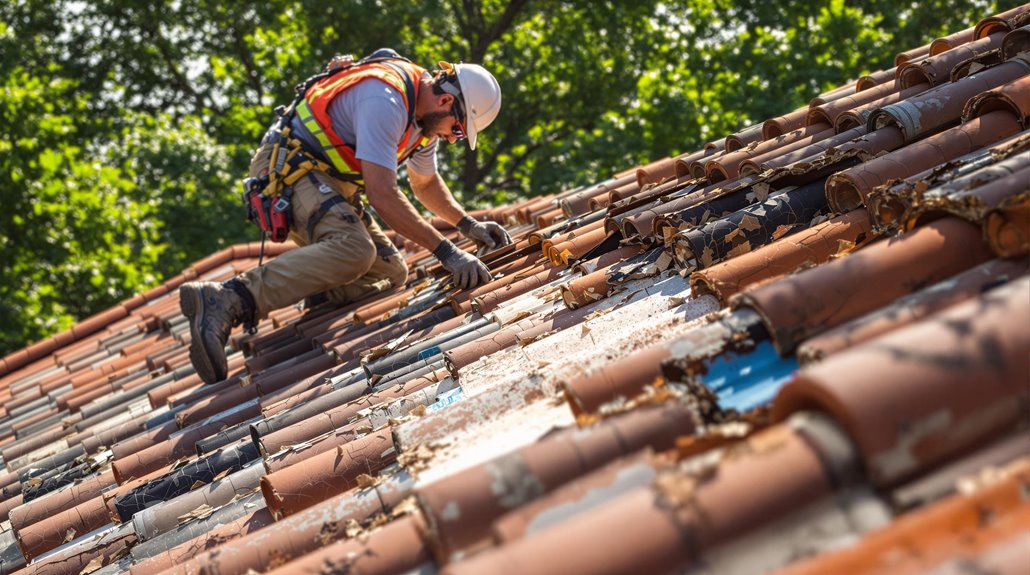
Understanding the vulnerabilities of clay and concrete tile roofs allows property owners to effectively address potential damage before it compromises the roofing system.
Tile deterioration commonly occurs through cracked or broken tiles, degraded underlayment, and poor installation practices. These issues create pathways for moisture intrusion, particularly around roof valleys, chimneys, and other structural penetrations.
Weather conditions greatly impact tile roof integrity. Strong winds can dislodge tiles, while severe storms and hail may cause fractures.
Temperature fluctuations and UV radiation weaken materials over time, especially affecting clay tiles. In freezing conditions, trapped moisture can expand and create cracks in concrete tiles.
Regular inspections, prompt repairs, and proper maintenance of gutters and flashing are essential preventive measures to maintain the roof's protective function.
Homeowners should keep thorough maintenance records to support potential insurance claims for sudden damage coverage.
Essential Repair Techniques for Clay and Concrete Tiles
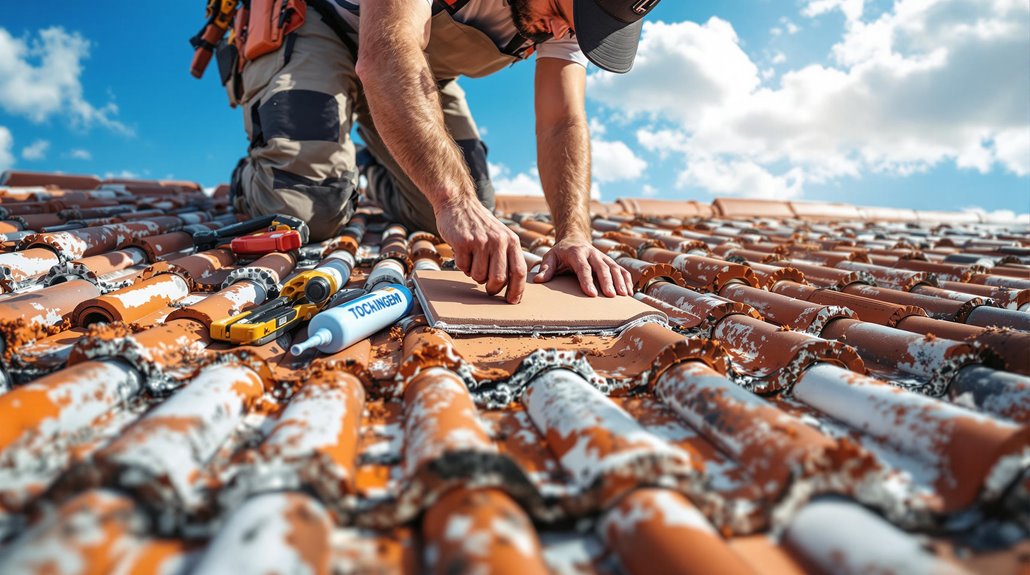
Effective repair of clay and concrete tile roofs requires specialized tools, proper techniques, and careful attention to material properties. Repair safety demands proper equipment, including non-slip shoes, gloves, and safety harnesses for elevated work. For tile maintenance, technicians must handle materials with precision, using pry bars or flat-blade shovels to remove damaged pieces without compromising surrounding tiles. Thorough damage documentation requirements must be met before filing any insurance claims.
| Material Type | Primary Repair Method | Essential Tools |
|---|---|---|
| Clay Tiles | RT-600 for cracks | Roofing cement |
| Concrete Tiles | Foam adhesive | Pry bar |
| Both Types | Mortar sealing | Replacement tiles |
| Emergency Fix | Temporary sealant | Waterproof tape |
Critical steps include inspecting the waterproof membrane, clearing debris from valleys, and ensuring proper alignment of replacement tiles. Professionals must seal nail holes and verify that new tiles match existing patterns while maintaining structural integrity.
Professional Vs DIY Repair Considerations
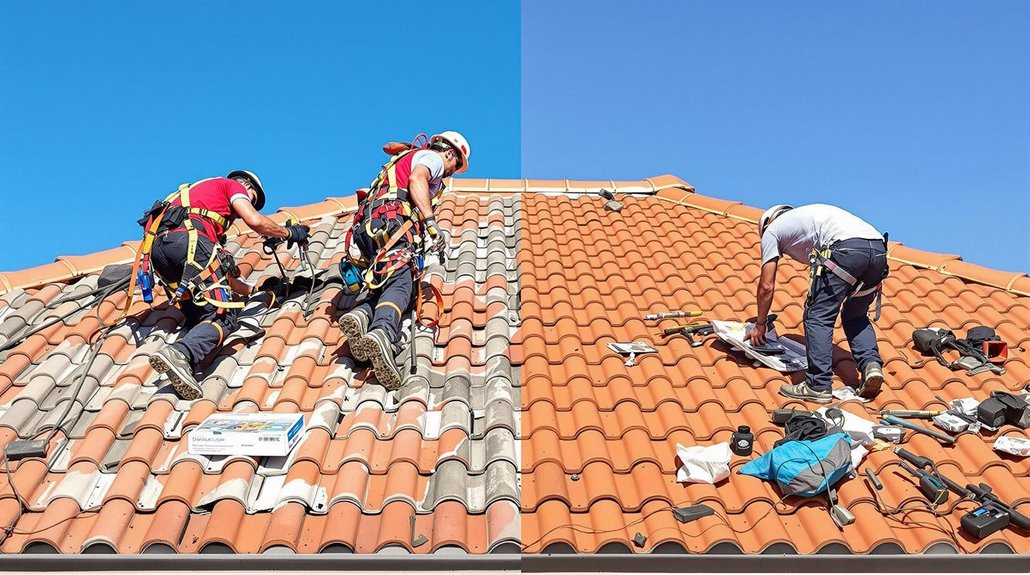
Deciding between professional and DIY repairs for clay and concrete tile roofs requires careful evaluation of multiple factors, including project complexity, safety considerations, and technical expertise.
While DIY techniques can be suitable for minor repairs and offer cost savings, professional standards often provide superior results for extensive damage or complex installations.
Professional contractors bring thorough assessment capabilities, specialized tools, and liability insurance coverage, ensuring repairs meet building codes and manufacturer specifications. They also offer warranties that protect homeowners' investments.
Conversely, DIY approaches allow for immediate response to minor issues and can be cost-effective when homeowners possess adequate skills.
However, the technical nature of clay and concrete tile repairs, combined with safety risks associated with roof work, often makes professional intervention the more prudent choice for ensuring long-term roof integrity.
For insurance claims involving tile roof damage, public adjusters can maximize potential settlement outcomes while ensuring proper documentation and compliance with policy requirements.
Cost Analysis: Materials, Labor, and Long-Term Value
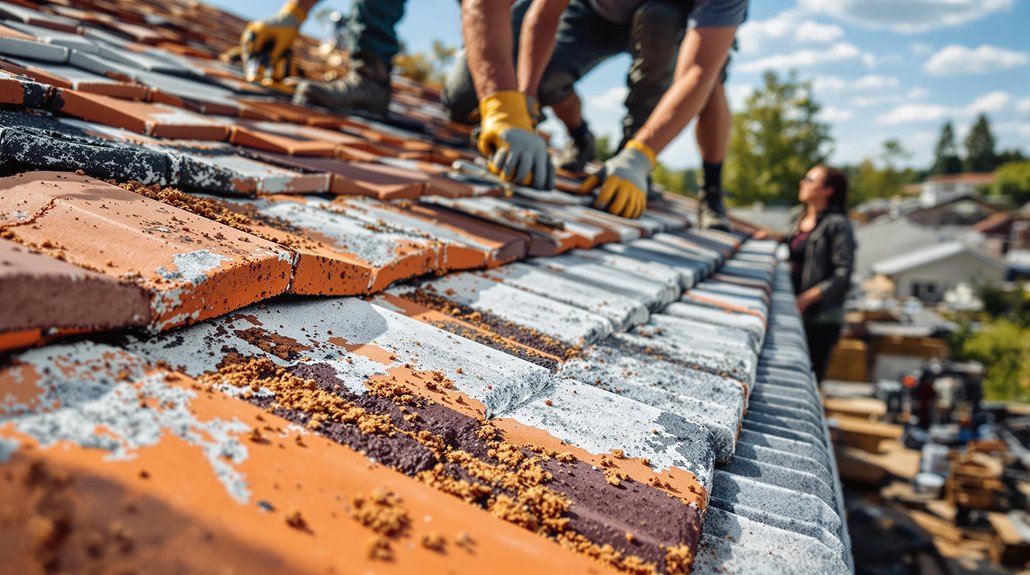
A thorough cost analysis of clay and concrete tile roof repairs encompasses multiple financial variables, from initial material selection to long-term maintenance implications.
When conducting a cost comparison, property owners must consider both immediate expenses and future value.
Key cost factors include:
- Initial material costs: Concrete tiles ($3-$5/sq ft) versus clay tiles ($3-$11/sq ft), with installation adding $4-$14 per square foot.
- Labor expenses: $50-$100 per hour, with minimum job fees ranging from $300-$500.
- Long-term value: Clay tiles lasting up to 100 years versus concrete's 50-100 years, impacting overall investment return.
While concrete tiles offer lower upfront costs, clay tiles generally provide superior durability and reduced maintenance needs, potentially offering better long-term value despite higher initial investment.
Working with public adjusters can increase insurance claim settlements by 40-350% for tile roof repairs, offsetting higher material and installation costs.
Insurance Coverage and Maintenance Requirements
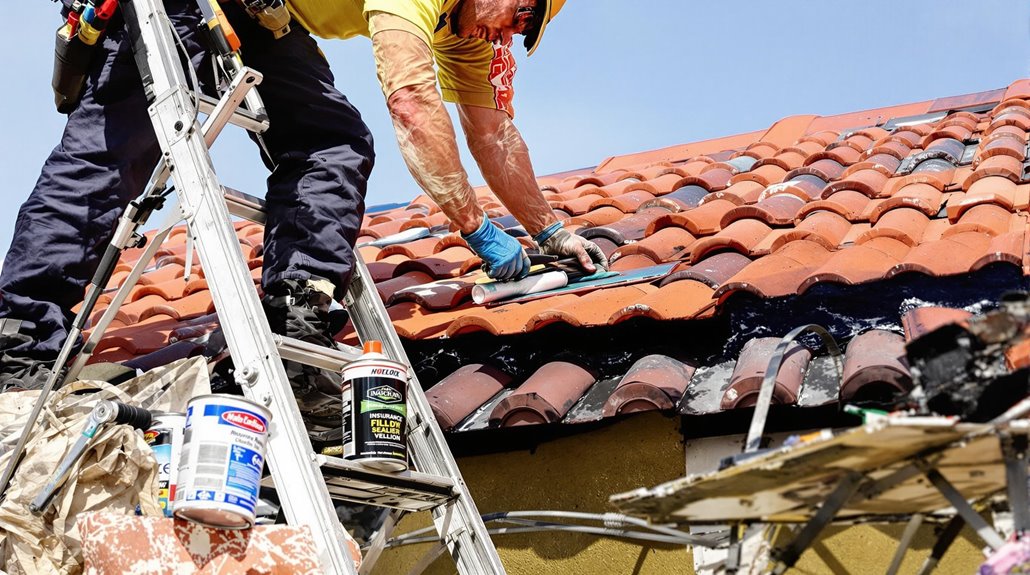
The intersection of insurance coverage and maintenance requirements plays a crucial role in protecting clay and concrete tile roof investments. Understanding your insurance policy specifics while maintaining a thorough maintenance checklist guarantees ideal coverage and longevity. Regular inspections and proper documentation of maintenance activities strengthen insurance claims when needed.
| Aspect | Clay Tiles | Concrete Tiles |
|---|---|---|
| Insurance Coverage | Often higher value coverage | Standard coverage rates |
| Inspection Frequency | Bi-annual | Annual |
| Maintenance Level | Gentle handling required | Moderate maintenance |
| Common Issues | Cracking, brittleness | Porosity, moisture damage |
| Preventative Care | Regular sealing, careful cleaning | Waterproofing, algae treatment |
Both materials require specific maintenance protocols to maintain insurance coverage legitimacy, with documentation of professional inspections typically necessary for claim approval.
The Benefits Of Consulting A Public Adjuster For Roof Repairs

Public adjusters provide specialized expertise in managing insurance claims for clay and concrete tile roof repairs, offering objective damage assessments that thoroughly document all affected areas.
Their professional representation streamlines the complex claims process while managing negotiations with insurance companies, reducing administrative burden on property owners.
Through their detailed understanding of policy coverage and current repair costs, public adjusters typically secure higher claim settlements that better reflect the true extent of roof damage and necessary repairs.
Expertise In Insurance Claims
When dealing with clay and concrete tile roof damage, consulting a public adjuster can greatly enhance the insurance claims process and final settlement outcomes. Their expertise in claim documentation and negotiation strategies guarantees extensive coverage for all damages while maximizing settlement values.
Public adjusters provide three essential services that streamline the claims process:
- Thorough documentation through detailed photographs and evidence collection
- Expert policy interpretation to identify maximum coverage entitlements
- Professional representation during insurance company negotiations
Their specialized knowledge helps avoid common pitfalls while reducing stress for property owners.
Objective Damage Assessment
Professional damage assessment by a public adjuster serves as a cornerstone for successful clay and concrete tile roof repair claims. Through advanced damage assessment techniques and adherence to strict roof inspection standards, public adjusters conduct thorough evaluations that identify both obvious and concealed damages.
Their objective assessment process encompasses extensive documentation through detailed photographs and reports, guaranteeing all damage points are properly recorded. This systematic approach helps prevent claim underpayment by accounting for structural integrity issues that might otherwise go unnoticed.
Public adjusters' expertise in identifying hidden damages proves particularly valuable for clay and concrete tile roofs, where subtle cracks or displacement can lead to significant future problems if left unaddressed. Their detailed evaluations also ensure compliance with insurance requirements while supporting maximum claim settlements.
Streamlined Claim Process
The streamlined claim process offered through experienced public adjusters transforms complex roof repair claims into manageable, efficient procedures.
Through strategic claims management strategies and deep understanding of insurance policy nuances, adjusters facilitate faster settlements while ensuring thorough coverage for tile roof repairs.
Key advantages of professional claims assistance include:
- Simplified communication through a single point of contact, reducing miscommunications and expediting documentation exchange
- Expert navigation of complex legal frameworks and property damage assessments, minimizing potential disputes
- Accelerated repair timelines through systematic claim tracking and regular follow-ups with insurance providers
This structured approach not only expedites the repair process but also provides homeowners with professional leverage during settlement negotiations, ultimately reducing stress and ensuring fair compensation for roof damage.
Higher Claim Payouts & Settlements
Securing ideal compensation for clay and tile roof repairs often hinges on partnering with public adjusters, who consistently achieve higher claim settlements through their specialized expertise and systematic approach.
Their claim strategies encompass thorough damage assessments, detailed documentation, and expert policy interpretation to identify all covered damages.
Public adjusters employ sophisticated negotiation techniques, leveraging their knowledge of repair costs and insurance company practices to maximize settlements.
They document hidden damages, prepare evidence-based claims, and utilize comparative analysis to guarantee fair compensation.
Understanding complex policy terms and future repair implications, adjusters can secure settlements up to 50% higher than initial offers.
Their expertise in roofing materials and installation costs proves particularly valuable when dealing with specialized systems like clay and concrete tile roofs.
About The Public Claims Adjusters Network (PCAN)
Public Claims Adjusters Network (PCAN) serves as an essential intermediary system connecting property owners with licensed public adjusters who specialize in insurance claim settlements.
The network facilitates efficient claims processing while ensuring policyholders receive fair compensation for their damaged tile roofs through expert claims negotiation.
Key benefits of utilizing PCAN's public adjuster roles include:
- Thorough policy analysis and damage assessment to maximize claim potential
- Professional documentation management and submission of all required materials
- Expert negotiation with insurance companies to secure ideal settlements
PCAN operates under strict state-specific regulations, with adjuster fees typically ranging from 10-20% of the final settlement amount.
These fees are transparently disclosed upfront and generally work on a contingency basis, ensuring aligned interests between adjusters and property owners.
Frequently Asked Questions
Can Tile Roofs Be Walked on During Installation of Solar Panels?
While walking on tile roofs during solar panel installation is necessary, professionals must follow specific safety protocols, create temporary pathways, and use specialized racking systems to minimize damage during maintenance.
How Do Extreme Temperature Fluctuations Affect the Lifespan of Roof Tiles?
Like a rubber band stretched repeatedly, extreme temperature swings trigger constant thermal expansion and contraction in roof tiles, accelerating wear and leading to significant lifespan reduction through cracking and deterioration.
Are Specific Tile Colors More Effective at Reflecting Heat?
Light-colored tiles demonstrate superior heat reflection properties, while darker shades increase heat absorption. White tiles reflect up to 80% of sunlight, making them ideal for temperature regulation in roofing applications.
What Impact Does Salt Air Exposure Have on Clay Versus Concrete Tiles?
Atmospheric salinity affects roofing materials distinctly: clay tiles demonstrate superior durability against salt air exposure, while concrete tiles require increased maintenance and protective sealing to prevent degradation from coastal environmental conditions.
Can Existing Roof Structures Support the Weight of Converting to Tile Roofing?
Existing roof structures require professional assessment and engineering evaluation to determine load-bearing capacity. Weight distribution considerations and potential structural reinforcement needs must be analyzed before converting to tile roofing.
References
- https://tornadoroofing.com/everything-you-need-to-know-about-repairing-roof-tiles/
- https://gogryphon.com/blog/clay-vs-concrete-roof-tiles
- https://www.aabcoroofinginc.com/types-of-tile-roof-repairs/
- https://eaglewatchroofing.com/roofing-materials/clay-tile-vs-concrete-tile/
- https://rd-cr.net/clay-tile-roof-repair/
- https://allpointstile.com/3-types-of-roofing-tiles-and-their-characteristics-clay-concrete-and-slate/
- https://pinnaclehomeimprovements.com/clay-vs-concrete-roof-tiles/
- https://www.cedur.com/clay-vs-concrete-roof-tiles
- https://roofclaim.com/installing-clay-or-concrete-roof-tiles/
- https://www.bravarooftile.com/blog/clay-vs-concrete-roof-tiles/
